Mechanical Property Comparison of Geopolymer Brick Dried by Electrical and Passive Solar Devices with Phase Change Material (Paraffin Wax)
Abstract
:1. Introduction
2. Materials and Methods
2.1. Electric Oven Drying
2.2. Solar Drying without a PCM
2.3. Solar Drying with a PCM
2.4. Open-Sun Drying
3. Results
4. Discussion
5. Conclusions
- ➢
- GPBs constructed from fly ash waste and other ingredients undergo full curing in all four methods.
- ➢
- A solar dryer with a PCM consumes 2 h less curing time when compared to all other methods [21].
- ➢
- ➢
- Solar-dried bricks with a PCM and without a PCM exhibit 7.84% and 1.7% higher compressive strength, 34.2% and 12.3% higher tensile split strength, and 25.25% and 15.15% higher flexural strength when compared to electric-oven-dried bricks, respectively.
- ➢
- Solar drying with a PCM shows 6.1% higher compressive strength, 19.5% higher tensile split strength, and 8.1% higher flexural strength when compared to solar drying without a PCM.
- ➢
- Open-sun drying shows 1.8%, 8%, and 9.8% higher compressive strength;14.3%, 36.5%, and 53.4% higher tensile split strength; and 8.1%, 17.5%, and 35.35% higher flexural strength properties when compared to solar drying with a PCM, solar drying without a PCM, and electrical drying, respectively.
- ➢
- Open-sun drying may cause the degradation of materials in GPBs, which may lead to extremely dry conditions inside GPBs that may not be suitable from an application point of view.
- ➢
- The use of PCMs like paraffin wax in solar dryers has a pronounced effect on the curing time and mechanical properties of GPBs.
- ➢
- When sustainability goals are concerned, solar energy is a better performer when compared to electrical energy. From this research work, we conclude that by using solar energy in drying applications, we can save high-grade electrical energy from an energy and economic point of view.
- ➢
- GPBs are finding applications in construction sectors as their properties are in accordance with concrete design standards.
- ➢
- Newer PCMs (organic or inorganic) may be tested inside a solar dryer for the curing of GPBs, which forms the scope for future work. Along with that, the way in which PCMs influence the mechanical properties of GPBs can be studied. Also, a thermal degradation study of PCMs is suggested as a scope for future studies aiming to understand the entropy changes occurring inside PCMs so that a correlation between degradation and the life of PCMs for solar dryer applications can be established.
Author Contributions
Funding
Data Availability Statement
Acknowledgments
Conflicts of Interest
References
- Gopinath, G.; Muthuvel, S.; Muthukannan, M.; Sudhakarapandian, R.; Kumar, B.P.; Kumar, C.S.; Thanikanti, S.B. Design, development, and performance testing of thermal energy storage based solar dryer system for seeded grapes. Sustain. Energy Technol. Assess. 2022, 51, 101923. [Google Scholar] [CrossRef]
- IS 10262; Guidelines for Concrete Mix Design, Proportioning [CED2 Cement and Concrete]. Bureau of Indian Standards: New Delhi, India, 2009.
- Ramachandran, A.; Venkatasubramani, R.; Venkataraman, S.; Rangan, B.V. Modified guidelines for geopolymer concrete mix design using Indian standard. Artic. Asian J. Civ. Eng. 2012, 13, 353–364. [Google Scholar]
- Azaizia, Z.; Kooli, S.; Hamdi, I.; Elkhal, W.; Guizani, A.A. Experimental study of a new mixed mode solar greenhouse drying system with and without thermal energy storage for pepper. Renew. Energy 2020, 145, 1972–1984. [Google Scholar] [CrossRef]
- Malakar, S.; Arora, V.K. Development of phase change material assisted evacuated tube solar dryer: Investigation of thermal profile, drying characteristics, and functional properties of pumpkin slices. Innov. Food Sci. Emerg. Technol. 2022, 80, 103109. [Google Scholar] [CrossRef]
- Langová, R.; Jůzl, M.; Cwiková, O.; Kos, I. Effect of Different Method of Drying of Five Varieties Grapes (Vitisvinifera L.) on the Bunch Stem on Physicochemical, Microbiological, and Sensory Quality. Foods 2020, 9, 1183. [Google Scholar] [CrossRef] [PubMed]
- De Simone, N.; Capozzi, V.; de Chiara, M.L.V.; Amodio, M.L.; Brahimi, S.; Colelli, G.; Drider, D.; Spano, G.; Russo, P. Screening of Lactic Acid Bacteria for the Bio-Control of Botrytis cinerea and the Potential of Lactiplantibacillusplantarum for Eco-Friendly Preservation of Fresh-Cut Kiwifruit. Microorganisms 2021, 9, 773. [Google Scholar] [CrossRef]
- BharaniPriya, A.; Dineshkumar, M.; Naveen Romi, J.; Vijay Nepolean, A.; Kirubakaran, V. Solar Dryer Integrated with Thermal Energy Storage Systems for the Preparation of Dry Grapes in the Farmyard. Sustainable Rural Farming Approach. Res. J. Chem. Environ. 2020, 24, 60–65. [Google Scholar] [CrossRef]
- Gorjian, S.; Hosseingholilou, B.; Jathar, L.D.; Samadi, H.; Samanta, S.; Sagade, A.A.; Kant, K.; Sathyamurthy, R. Recent Advancements in Technical Design and Thermal Performance Enhancement of Solar Greenhouse Dryers. Sustainability 2021, 13, 7025. [Google Scholar] [CrossRef]
- Srivastava, A.; Anand, A.; Shukla, A.; Kumar, A.; Buddhi, D.; Sharma, A. A comprehensive overview on solar grapes drying: Modeling, energy, environmental and economic analysis. Sustain. Energy Technol. Assess. 2021, 47, 101513. [Google Scholar] [CrossRef]
- Bassey, E.J.; Cheng, J.-H.; Sun, D.-W. Novel nonthermal and thermal pretreatments for enhancing drying performance and improving quality of fruits and vegetables. Trends Food Sci. Technol. 2021, 112, 137–148. [Google Scholar] [CrossRef]
- Sridhar, K.; Charles, A.L. Mathematical Modeling to Describe Drying Behavior of Kyoho (Vitislabruscana) Skin Waste: Drying Kinetics and Quality Attributes. Processes 2022, 10, 2092. [Google Scholar] [CrossRef]
- Elavarasan, E.; Kumar, Y.; Mouresh, R.; Natarajan, S.K. Experimental investigation of drying tomato in a double slope solar dryer under natural convection. In Advances in Mechanical and Materials Technology: Select Proceedings of EMSME 2020; Springer: Singapore, 2022; pp. 179–190. [Google Scholar] [CrossRef]
- Saikia, D.; Nayak, P.K.; Krishnan, K.R.; Kondareddy, R.; Lakshmi, D. Development of indirect type solar dryer and experiments for estimation of drying parameters of dhekia (Diplaziumesculentum). Mater. Today Proc. 2022, 56, 774–780. [Google Scholar] [CrossRef]
- Badaoui, O.; Hanini, S.; Djebli, A.; Haddad, B.; Benhamou, A. Experimental and modelling study of tomato pomace waste drying in a new solar greenhouse: Evaluation of new drying models. Renew. Energy 2018, 133, 144–155. [Google Scholar] [CrossRef]
- Singh, S.; Gill, R.; Hans, V.; Mittal, T. Experimental performance and economic viability of evacuated tube solar collector assisted greenhouse dryer for sustainable development. Energy 2022, 241, 122794. [Google Scholar] [CrossRef]
- Albitar, M.; Visintin, P.; Ali, M.S.M.; Drechsler, M. Assessing behaviour of fresh and hardened geopolymer concrete mixed with class-F fly ash. KSCE J. Civ. Eng. 2015, 19, 1445–1455. [Google Scholar] [CrossRef]
- Bai, Y.; Guo, W.; Wang, J.; Xu, Z.; Wang, S.; Zhao, Q.; Zhou, J. Geopolymer bricks prepared by MSWI fly ash and other solid wastes: Moulding pressure and curing method optimisation. Chemosphere 2022, 307, 135987. [Google Scholar] [CrossRef]
- Shi, H.; Ma, H.; Tian, L.; Yang, J.; Yuan, J. Effect of microwave curing on metakaolin-quartz-based geopolymer bricks. Constr. Build. Mater. 2020, 258, 120354. [Google Scholar] [CrossRef]
- Maaze, M.R.; Shrivastava, S. Design development of sustainable brick-waste geopolymer brick using full factorial design methodology. Constr. Build. Mater. 2023, 370, 130655. [Google Scholar] [CrossRef]
- Capossio, J.P.; Fabani, M.P.; Reyes-Urrutia, A.; Torres-Sciancalepore, R.; Deng, Y.; Baeyens, J.; Rodriguez, R.; Mazza, G. Sustainable Solar Drying of Brewer’s Spent Grains: A Comparison with Conventional Electric Convective Drying. Processes 2022, 10, 339. [Google Scholar] [CrossRef]
- Ganesh, A.C.; Muthukannan, M. Development of high performance sustainable optimized fiber reinforced geopolymer concrete and prediction of compressive strength. J. Clean. Prod. 2021, 282, 124543. [Google Scholar] [CrossRef]
- Shanmugam, V.; Rajendran, D.J.J.; Babu, K.; Rajendran, S.; Veerasimman, A.; Marimuthu, U.; Singh, S.; Das, O.; Neisiany, R.E.; Hedenqvist, M.S.; et al. The mechanical testing and performance analysis of polymer-fibre composites prepared through the additive manufacturing. Polym. Test. 2021, 93, 106925. [Google Scholar] [CrossRef]
- Saliby, A.; Kovács, B. Minimization of annual energy consumption by incorporating phase change materials into building components: A comprehensive review. Heat Transf. Res. 2023, 54, 65–91. [Google Scholar] [CrossRef]
- Mehta, P.; Bhatt, N.; Bassan, G.; Kabeel, A.E. Performance improvement and advancement studies of mixed-mode solar thermal dryers: A review. Environ. Sci. Pollut. Res. 2022, 29, 62822–62838. [Google Scholar] [CrossRef] [PubMed]
- Mall, P.; Singh, D. Comparative study of performance of indirect mode with PCM and mixed mode solar dryer for coriander leaves. Int. J. Appl. Eng. Res. 2018, 13, 5909–5919. [Google Scholar]
- Palacio, M.; Ramírez, C.; Carmona, M.; Cortés, C. Effect of phase-change materials in the performance of a solar air heater. Sol. Energy 2022, 247, 385–396. [Google Scholar] [CrossRef]
- Wang, H.; Lu, W.; Wu, Z.; Zhang, G. Parametric analysis of applying PCM wallboards for energy saving in high-rise lightweight buildings in Shanghai. Renew. Energy 2020, 145, 52–64. [Google Scholar] [CrossRef]
- Essalhi, H.; Benchrifa, M.; Tadili, R. Effect of Natural and Forced Ventilation on Drying of Kiwi in an Indirect Solar Dryer. In Sustainable Energy Development and Innovation: Selected Papers from the World Renewable Energy Congress (WREC) 2020; Springer: Lisbon, Portugal, 2022; pp. 177–180. [Google Scholar] [CrossRef]
- César, L.-V.E.; Lilia, C.-M.A.; Octavio, G.-V.; Isaac, P.F.; Rogelio, B.O. Thermal performance of a passive, mixed-type solar dryer for tomato slices (Solanumlycopersicum). Renew. Energy 2020, 147, 845–855. [Google Scholar] [CrossRef]
- Atalay, H.; Çoban, M.T.; Kıncay, O. Modeling of the drying process of apple slices: Application with a solar dryer and the thermal energy storage system. Energy 2017, 134, 382–391. [Google Scholar] [CrossRef]
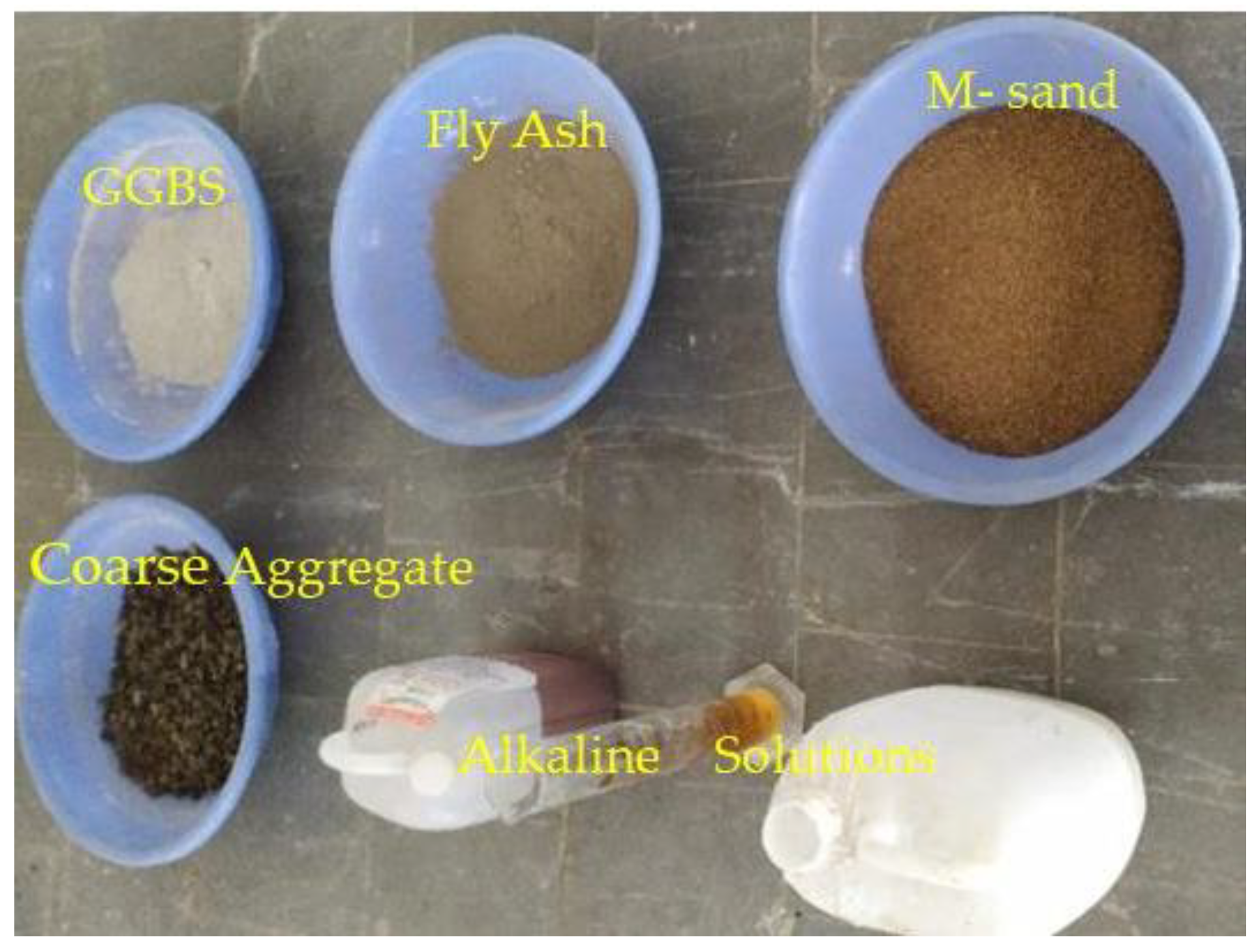
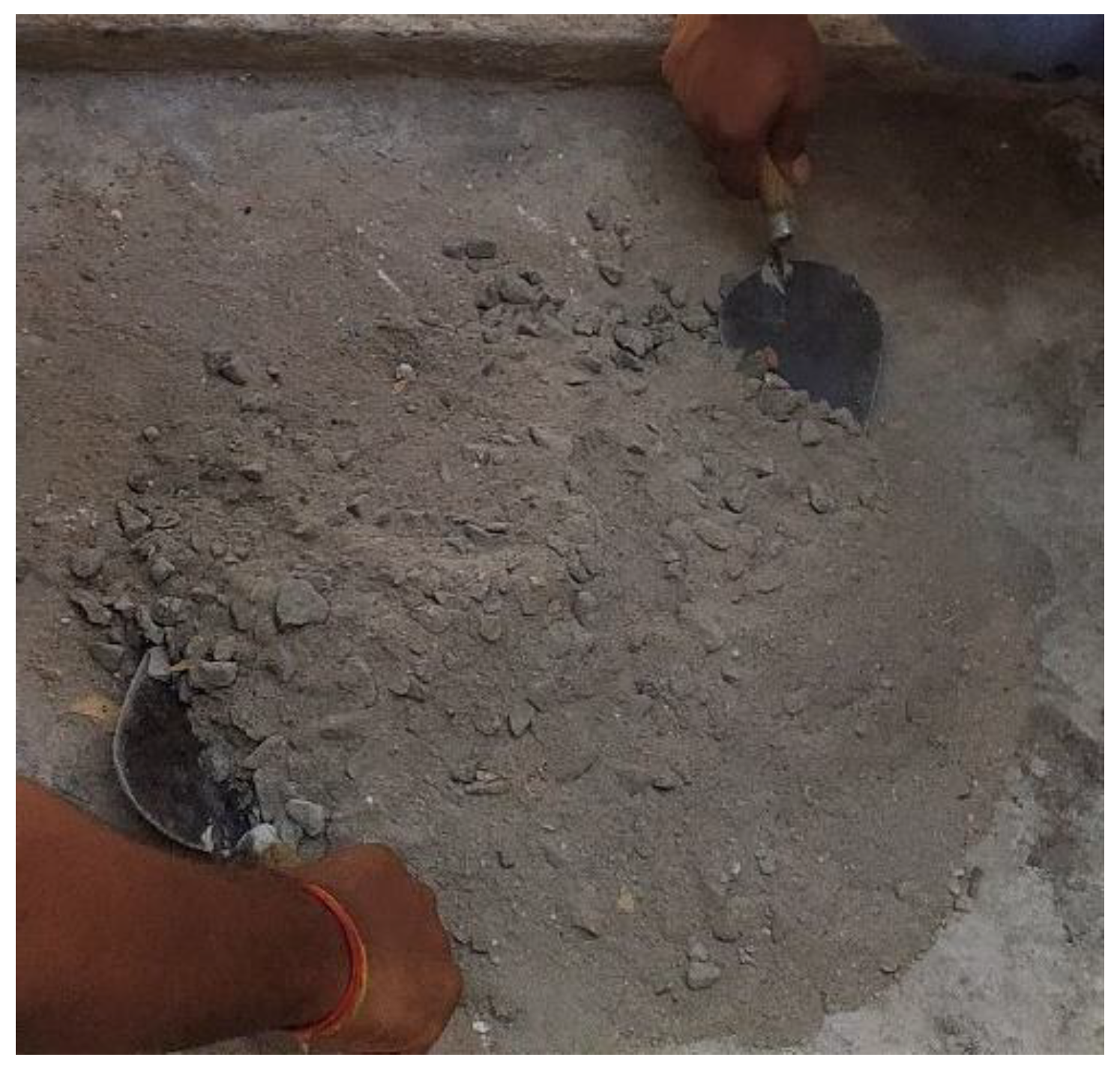
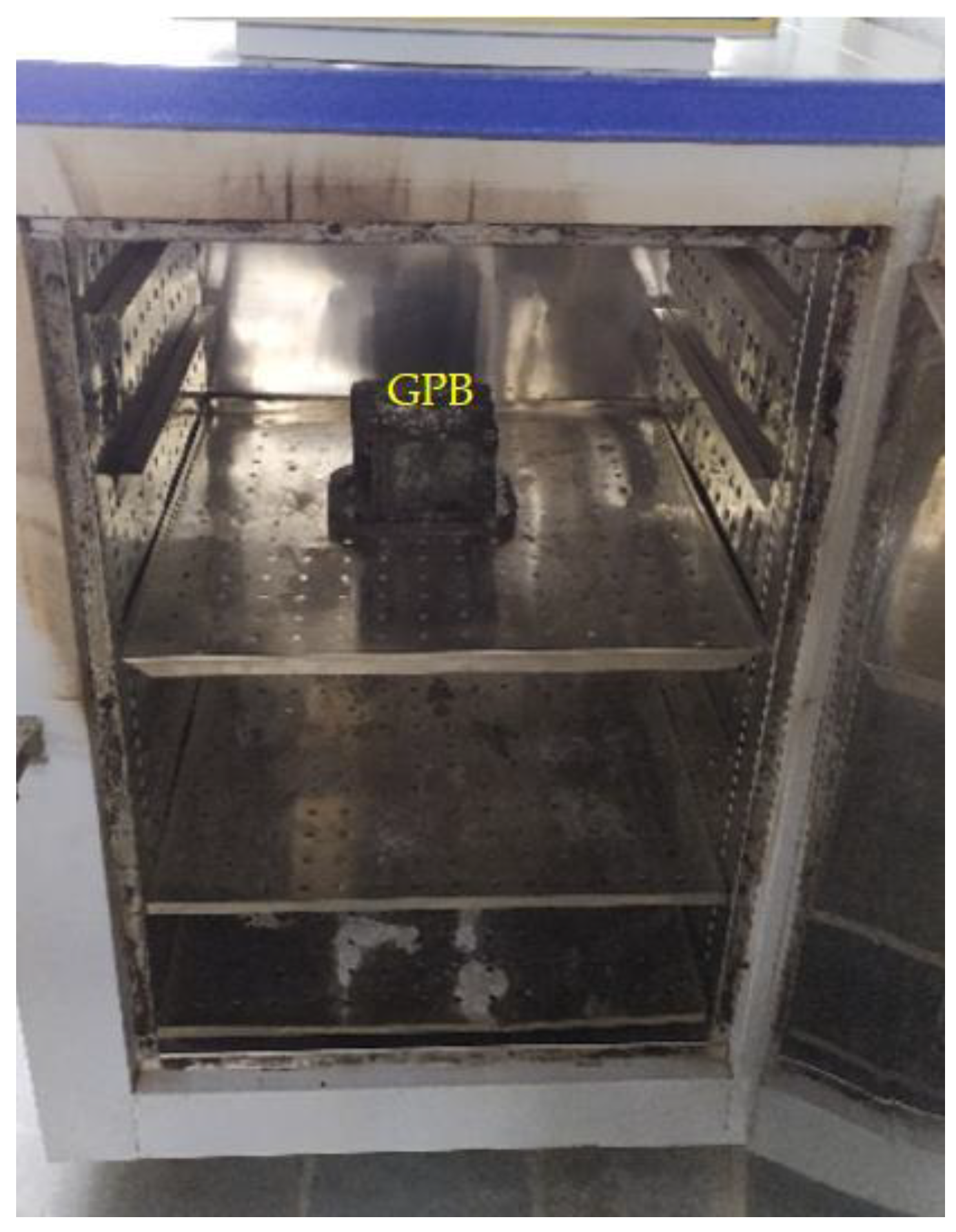


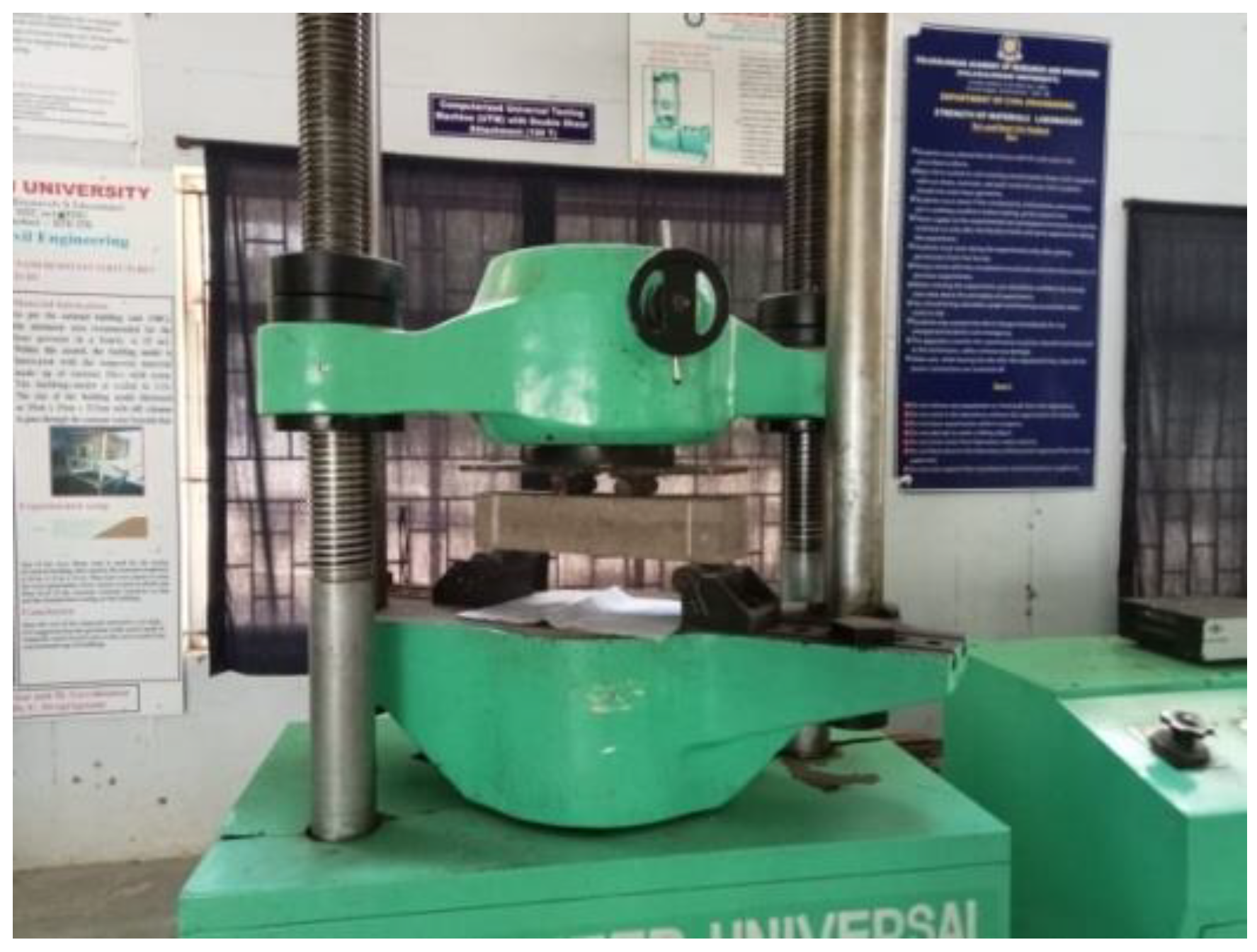

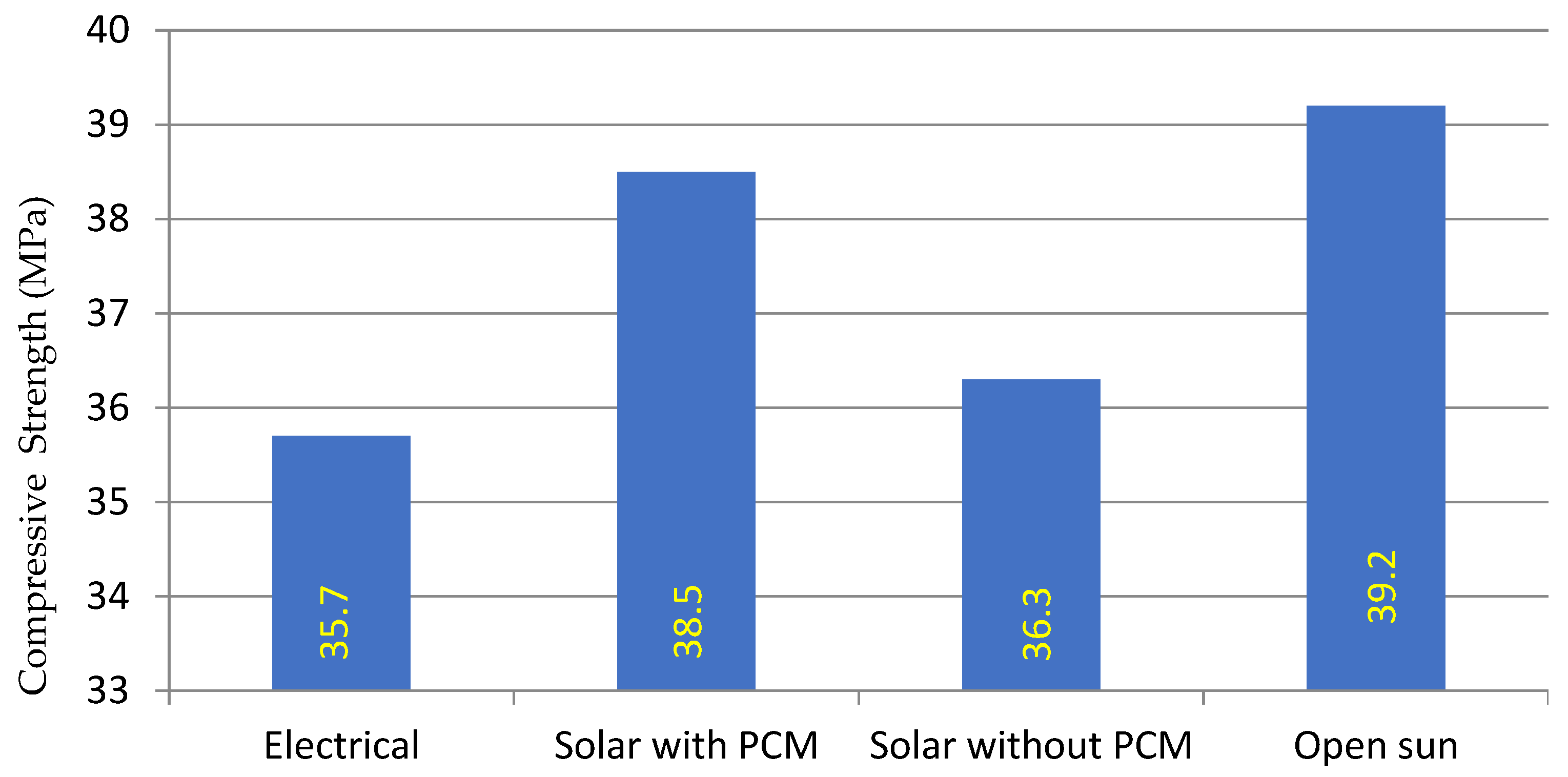
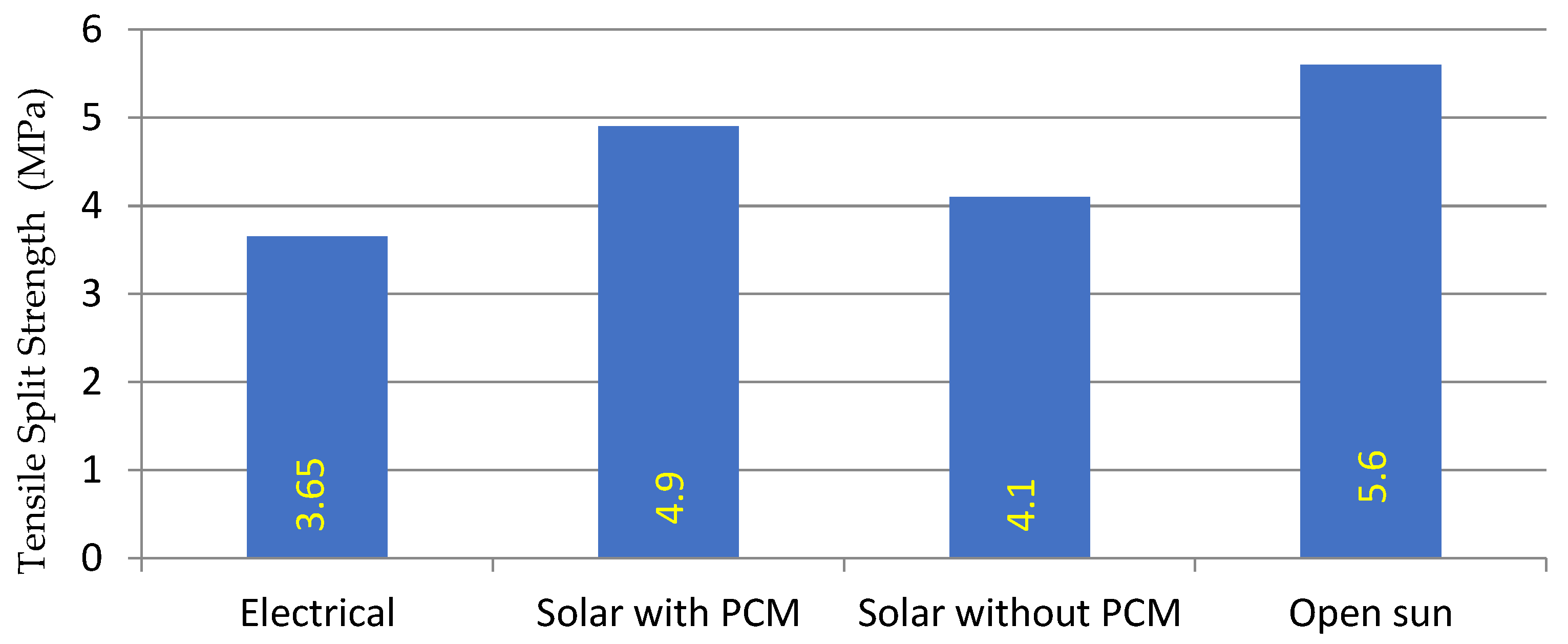
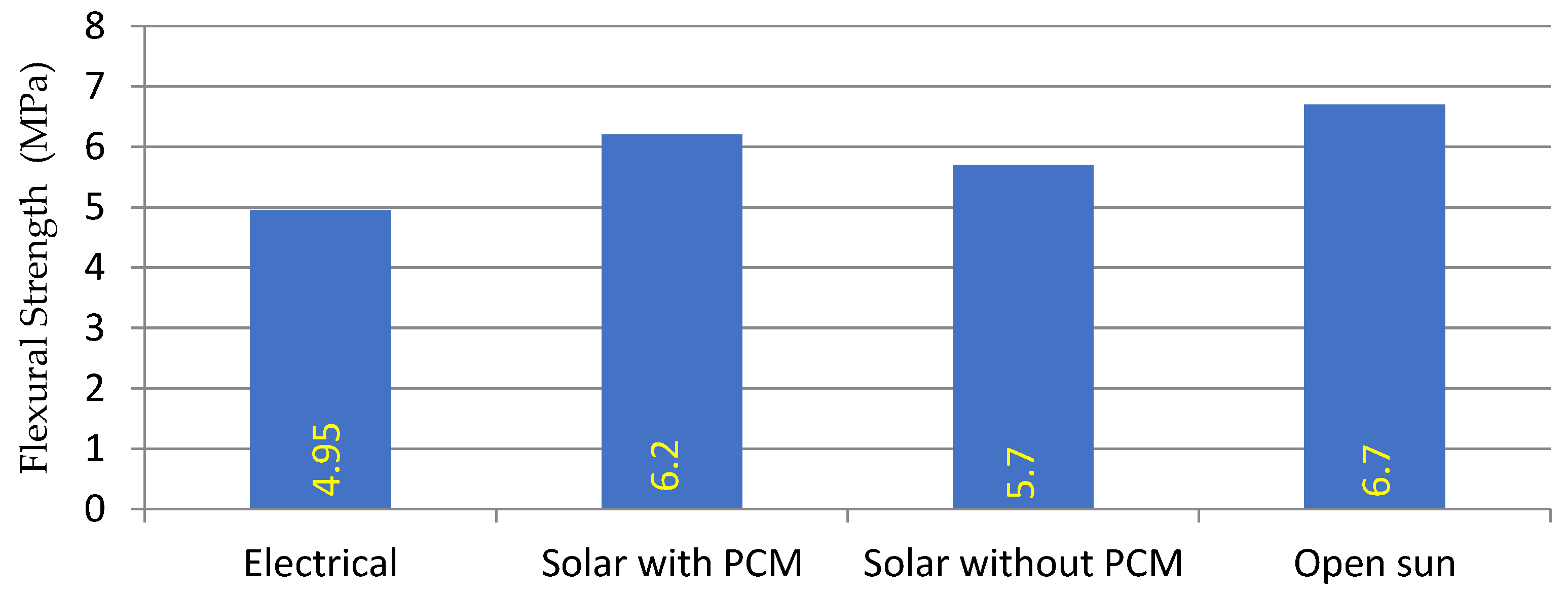
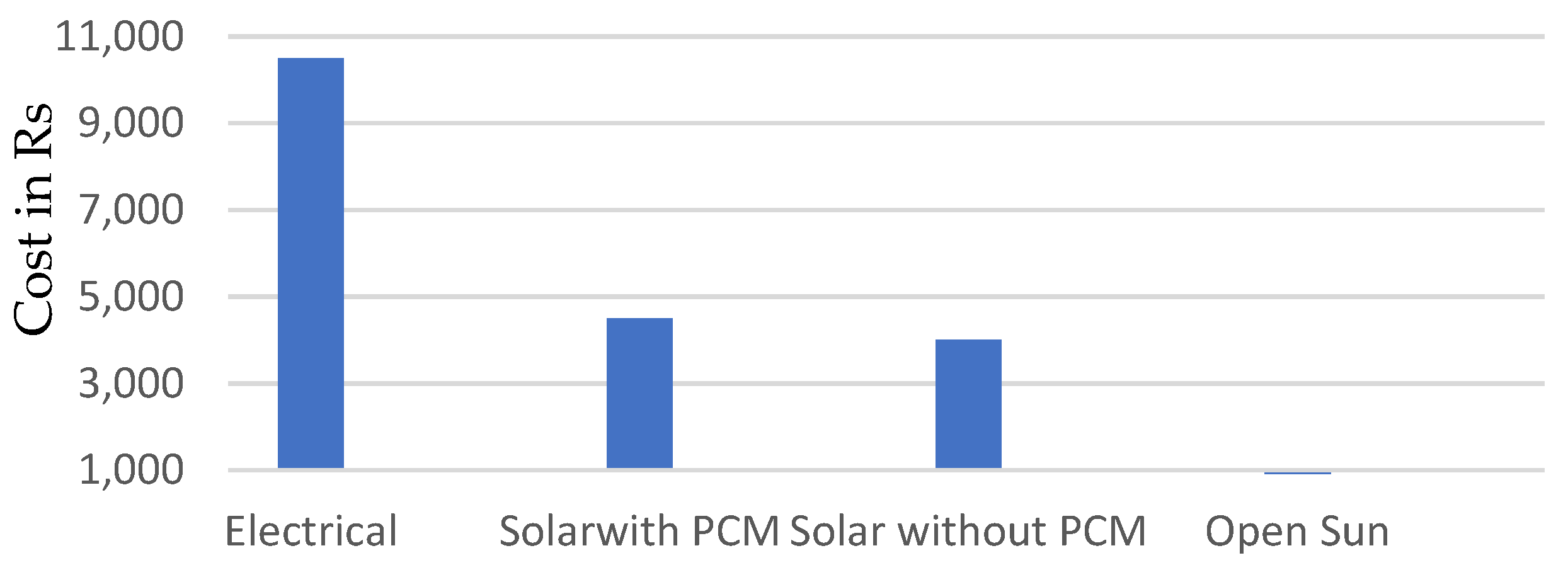
| PCM | Melting Temperature (°C) | Density (kg/m3) | Specific Heat (J/Kgk) | Thermal Conductivity (W/mK) | Latent Heat of Fusion (kJ/kg) | |||
|---|---|---|---|---|---|---|---|---|
| Solid | Liquid | Solid | Liquid | Solid | Liquid | |||
| Paraffin wax | 58 | 910 | 810 | 2000 | 2100 | 0.228 | 0.25 | 204 |
| Material | Weight in kg/m3 |
|---|---|
| Fly ash | 385 |
| GGBS—ground granulated blast furnace slag | 165 |
| M sand | 579.64 |
| Coarse aggregate 20 mm | 864.12 |
| AAS—alkaline activated solution | 335.5 |
| SSS—sodium silicate solution Na2SiO3 | 239.64 |
| NaOH | 95.86 |
| NaOH molarity | 12 |
| Alkaline/binder ratio | 0.61 |
| Precursor | SiO2 | Al2O3 | CaO | MgO | K2O | Fe2O3 | TiO2 | Na2O | SO3 |
|---|---|---|---|---|---|---|---|---|---|
| Fly Ash | 53 | 26 | 3 | 9 | 7 | 1.56 | 0.85 | 0.7 | 0.55 |
| Ground granulated blast furnace slag | 36 | 13 | 37 | 7 | 0.55 | 0.4 | 0.7 | 0.2 | 1.75 |
| Drying Method | Curing Time (Hours) | Compressive Strength (MPa) | Tensile Split Strength (MPa) | Flexural Strength (MPa) |
|---|---|---|---|---|
| Electrical drying | 24 | 35.70 | 3.65 | 4.95 |
| Solar drying with a PCM | 22 | 38.50 | 4.90 | 6.20 |
| Solar drying without a PCM | 24 | 36.30 | 4.10 | 5.70 |
| Open-sun drying | 24 | 39.20 | 5.60 | 6.70 |
| Sustainable Development Goal | Description |
|---|---|
| SDG 7 | Clean and affordable energy—usage of solar energy |
| SDG 8 | Economic growth—cheaper than electric energy |
| SDG 13 | Climate action and its impact—free from fossil fuels and emissions |
Disclaimer/Publisher’s Note: The statements, opinions and data contained in all publications are solely those of the individual author(s) and contributor(s) and not of MDPI and/or the editor(s). MDPI and/or the editor(s) disclaim responsibility for any injury to people or property resulting from any ideas, methods, instructions or products referred to in the content. |
© 2023 by the authors. Licensee MDPI, Basel, Switzerland. This article is an open access article distributed under the terms and conditions of the Creative Commons Attribution (CC BY) license (https://creativecommons.org/licenses/by/4.0/).
Share and Cite
Ashok Kumar, J.; Muthuvel, S.; Issac Selvaraj, R.V.; Ramoni, M.; Shanmugam, R.; Pandian, R.S. Mechanical Property Comparison of Geopolymer Brick Dried by Electrical and Passive Solar Devices with Phase Change Material (Paraffin Wax). Processes 2024, 12, 28. https://doi.org/10.3390/pr12010028
Ashok Kumar J, Muthuvel S, Issac Selvaraj RV, Ramoni M, Shanmugam R, Pandian RS. Mechanical Property Comparison of Geopolymer Brick Dried by Electrical and Passive Solar Devices with Phase Change Material (Paraffin Wax). Processes. 2024; 12(1):28. https://doi.org/10.3390/pr12010028
Chicago/Turabian StyleAshok Kumar, Jeevan, Sattanathan Muthuvel, Rajay Vedaraj Issac Selvaraj, Monsuru Ramoni, Ragavanantham Shanmugam, and Ranjitharamasamy Sudhakara Pandian. 2024. "Mechanical Property Comparison of Geopolymer Brick Dried by Electrical and Passive Solar Devices with Phase Change Material (Paraffin Wax)" Processes 12, no. 1: 28. https://doi.org/10.3390/pr12010028







